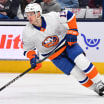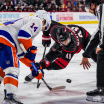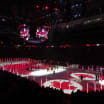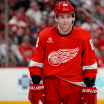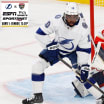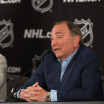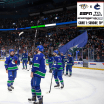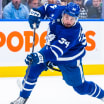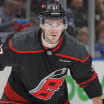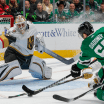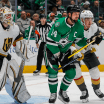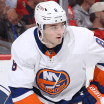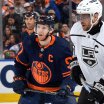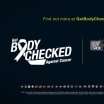Legendary hockey reporter and analyst Stan Fischler writes a weekly scrapbook for NHL.com. Fischler, known as "The Hockey Maven," shares his humor and insight with readers each Wednesday.
This week's edition features an early 1970s interview with Hockey Hall of Famer Ebbie Goodfellow, a star with the Detroit Red Wings as a center and then as a defenseman during the 1930s and early 1940s.
Voices from the Past: Ebbie Goodfellow
Hall of Famer excelled as center, defenseman for Red Wings in 1930s, early '40s.
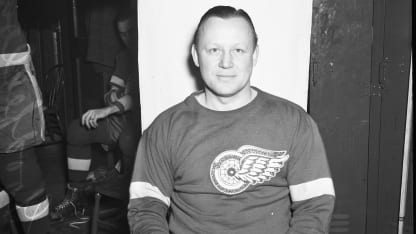
By
Stan Fischler
Special to NHL.com
Who got you interested in hockey?
I can thank my father for that. He was the biggest hockey fan in the world, with my mother right behind. He got a job on an experimental farm in Ottawa; thanks to him and the weather, I never had a problem getting ice time. We had natural ice from November to March, and I learned to play on Ottawa's outdoor park rinks. But if they were filled, we'd play on the frozen Rideau Canal in the shadows of the Parliament buildings. I can remember a game at an outdoor rink when the temperature was 30 degrees below zero (Fahrenheit). We all rode home afterwards, 15 miles, in a hay sleigh, pulled by a team of horses.
Which famous players from your era inspired you?
Ottawa was well-known for its hockey players, which meant I was following the careers of top local players who made good -- guys like
Frank Boucher
of the New York Rangers and
King Clancy
of Ottawa. The teams first played in Dey's Arena on natural ice. Then a big thing happened in 1919; a new indoor arena called the Ottawa Auditorium opened. It was a big deal because it was the first in our area to have artificial ice. This was quite something for the country's capital.
When did you think you could make it to the NHL?
When I started playing in school leagues, I got good enough to be recognized by a senior league team, the Ottawa Montagnards. I played for two years with them in the Ottawa Senior League, and it helped in an interesting way. The coach and general manager of the Detroit Cougars (later the Red Wings), Jack Adams, was an Ottawa boy so he was interested in good, young players coming from his hometown. Jack had one of his scouts check me out. The scout gave me a good report and I was signed by the Cougars farm club, the Detroit Olympics, which played in the old International League.
What did Jack Adams see in you?
He watched me firsthand when I played in the IHL. I was an all-star center and won the rookie of the year award. That got me a lot of attention. The write-ups had me as a great prospect, so Adams offered me a contract of $6,000 for two years. You have to remember that this was at the start of the Great Depression. Before signing, I checked with my buddy Pat Kilroy, who was playing for the Ottawa Senators, to get his advice on the money. He told me that it was a lot of cash for a rookie like me. There was talk that the Boston Bruins offered to buy me for $50,000, which was unheard of in 1929.
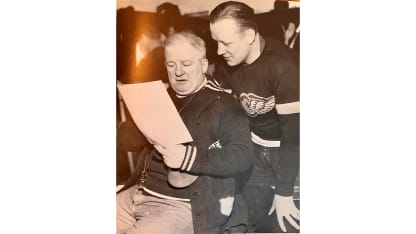
How were you handled as a brash NHL rookie?
Not well; at least not by the opposition. For starters, I arrived with a chip on my shoulder. In my first game we played the Bruins in Boston. At the time they were loaded with big fellows like
Eddie Shore
,
Lionel Hitchman
and
Dit Clapper
. Right in succession, Shore hit me, then Hitchman and then Clapper. By the time I came off the ice, I was a very cooled-off rookie. "Ebbie," I said to myself, "you'd better start picking your spots if you want to stay alive up here." I learned my lesson and wound up with 17 goals in 44 games. That wasn't half-bad considering that I played with a lot of different wingers.
What was your first Stanley Cup Final against Chicago in 1934 like?
It was a best-of-5, a touch-and-go series. The Black Hawks won the first two games, and then we came back and beat them in the third game. But the fourth one was a killer for me personally. It was 0-0 and went into a second overtime when I lost the whole thing for us. It was the middle of the period when, for some reason, I was back on defense. One of the Chicago players came skating down at me and I jabbed my stick out for a poke check. I missed the puck and he stepped on my stick and fell down. I didn't deliberately trip him, but I was still given a two-minute penalty. So I'm sitting in the penalty box, hoping we could kill the penalty. Just as I was about to leave the box Chicago scored. There went the game and the playoff for us -- all because of my penalty.
What do you remember about playing in the NHL's longest game on March 24, 1936?
We played the old Montreal Maroons at the Forum in the first game of the Stanley Cup Semifinals. It was 0-0 after regulation. Once overtime started, skating became more difficult. In those days they didn't resurface the ice; they just swept it with brooms after each period. That still left the ice full of cracks and sticky as heck. There wasn't any chance for spectacular plays. Meanwhile, the game went past midnight and then past 1 a.m.; still no score. By the fifth overtime period some guys were so tired it looked like they were just walking around out there. In the sixth overtime, we finally got a break thanks to our youngest player,
Mud Bruneteau
. The kid beat Maroons goalie
Lorne Chabot
after more than nine periods of hockey. I know the game is considered a classic because of its length; however, as for quality, it wasn't much once the overtimes dragged on and on.
How tough were you as a player compared to others?
Our big defenseman
Bucko McDonald
really knew how to body check. He was our hardest hitter, and I fit in right behind him.
Ching Johnson
, the great Rangers defenseman, once said I was the dirtiest player in hockey because of the way I'd developed of cutting him. I'd see Ching coming at me and at the last second I'd bring my stick up and down he'd go. Lucky for me, Ching was a lot like Bucko, a nice guy; too nice to really give me the business. Remember, though, that being rough and tough wasn't everything. The name of the game was scoring goals and winning, and I did my share of both. As I grew older, my penalty minutes went down, but age never bothered me. In 1940, when I was 32, I won the Hart Trophy; probably because I led all defensemen in scoring.
You played center and defense; which did you like best?
Playing up front was better for me because I could see both sides of the action. Up front a player can make more mistakes and not be criticized as much for them. When you're on defense and somebody skates by you, you wind up being the goat. This happened to me one night in Madison Square Garden and some guy yelled down from the balcony, "Goodfellow, you look like one of (New York Yankees owner) Jake Ruppert's brewery horses!"
You guys also had laughs. Let's hear a funny story.
Off the ice we had to be very careful of Jack Adams and his curfews. Once, after a loss to the Canadiens at The Forum, Jack was mad and slapped a 12:30 limit on us being out. We were staying at the Windsor Hotel, which had a back and front entrance. At the time we had a rookie,
Eddie Wiseman
, making his first road trip with us. We all went to a tavern, got something to eat and stayed there a half-hour past our deadline. I knew Jack would be waiting for us in the lobby. I was brave -- a veteran -- and went through the front door while the other guys ducked around to the rear. When Jack saw me, he said, "Where is everybody?" I played dumb and said I didn't know. Suddenly, he notices the guys at the back entrance, jumps out of his chair and races upstairs with me right behind him. He arrives just in time to hear a door shut so he dashes to the door, and barges in. The rookie, Wiseman, is lying peacefully in bed. snoring to beat the band with his blanket pulled to his neck. Jack pulls the blanket off and there's Wiseman with all his clothes on -- even his overcoat. Before Jack could say anything, Eddie looks up, rubs his eyes and says, "Geez, coach, it's awfully cold in here!"
How about your first Cup-winning year?
That was the first season (1935-36) when I finally switched from forward to defense. We had a memorable team; starting with a big line including
Larry Aurie
,
Herbie Lewis
and
Marty Barry
. On top of that Adams also had a bunch of other good players and a good one in goal --
Normie Smith
. We beat the Maroons in three straight, including the six-overtime classic, and we wound up in the Cup Final against Toronto in a best-of-5 series. We took them easily in the first two games at Olympia Stadium in Detroit], but they beat us at Maple Leaf Gardens in the third one. That set up the final in Toronto and the Leafs went ahead in the first period, but I tied it in the second and we went on to win 3-2. I remember what Adams said, explaining why we won. "We played aces against aces," he said, "and our aces topped theirs." Jack meant that the Lewis-Barry-Aurie line held their "Kid Line" of
[Joe Primeau
,
Busher Jackson
and
Charlie Conacher
to one shot in two games.
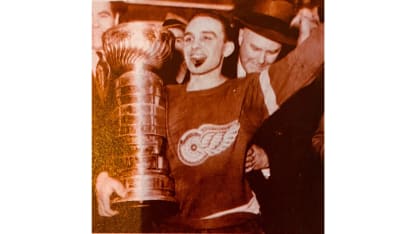
How did your playing career end?
I was pretty beat up by the start of the 1940s. But I tried one more season (1942-43), played 11 games and decided that I'd had it. Then Jack got some mileage out of me, using me as his "assistant coach." The way Jack's thought process worked: When we were losing, I was his assistant; when we were winning, however, he was the coach. By then Adams and I weren't getting along. One of Jack's failings was that if you started slipping over the hill you immediately fell out of favor, so I chose to retire. At that point, I could have done a lot of things outside of the game, but I still had hockey on my mind. Coaching looked glamorous to me and when Jim Norris asked me to try it with his St. Louis team in the American League, I got my wish and said I would.
Photo courtesy: HHoF Images
